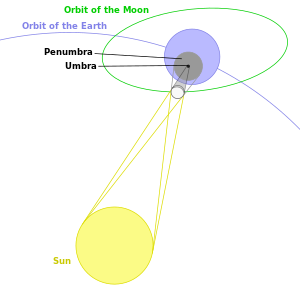Newest Post
// Posted by :Unknown
// On :Minggu, 27 Januari 2013
Gerhana matahari
Gerhana matahari berlaku apabila kedudukan bulan terletak di antara bumi dan matahari oleh itu menutup cahaya matahari samada separa atau sepenuhnya. Walaupun bulan lebih kecil, bayangan bulan mampu melindungi cahaya matahari sepenuhnya kerana bulan dengan purata jarak 384,400 kilometer adalah lebih dekat kepada bumi berbanding matahari yang mempunyai jarak purata 149,680,000 kilometer.
Gerhana matahari boleh dibahagi kepada 3 iaitu gerhana penuh, gerhana separuh, dan gerhana analus. Gerhana penuh apabila matahari ditutup sepenuhnya oleh bulan disebabkan bulan berada dekat ke bumi dalam orbit bujurnya, gerhana separuh apabila bulan hanya menutup sebahagian daripada matahari, dan gerhana analus yang terjadi apabila bulan hanya menutup sebahagian daripada matahari dan cahaya matahari selebihnya membentuk cincin bercahaya sekeliling bayangan bulan yang dikenali sebagai 'corona'.
Gerhana matahari berlaku selama 7 minit 30 saat pada tempat yang paling lama. Ketika gerhana matahari, orang ramai dilarang melihat ke arah matahari secara langsung kerana ini boleh merosakkan mata dan mengakibatkan buta.
Bagi mereka yang beragama Islam, mereka digalakkan untuk melakukan Solat Sunat Gerhanaketika berlakunya gerhana.
Pada 26 Januari 2009 berlaku lagi kekuasaan Allah pada alam ini iaitu fenomena Gerhana Matahari. Waktu berlaku pada waktu 16:20 waktu Malaysia dan berakhir dijangka 19:00. Adalah sebaik-baiknya memulakan solat gerhana matahari berjemaah di surau atau masjid di tempat anda kerana dapat mendengar khutbah yang bakal dibacakan oleh khatib. Hukum khutbah dan solat gerhana adalah sunat muakad(yang dituntut) , jadi meninggalkannya hukumnya makruh(dibenci) tanpa uzur syari'e.
There are four types of solar eclipses:
- A total eclipse occurs when the Sun is completely obscured by the Moon. The intensely bright disk of the Sun is replaced by the dark silhouette of the Moon, and the much fainter corona is visible. During any one eclipse, totality is visible only from at most a narrow track on the surface of the Earth.
- An annular eclipse occurs when the Sun and Moon are exactly in line, but the apparent size of the Moon is smaller than that of the Sun. Hence the Sun appears as a very bright ring, or annulus, surrounding the outline of the Moon.
- A hybrid eclipse (also called annular/total eclipse) transitions between a total and annular eclipse. At some points on the surface of the Earth it is visible as a total eclipse, whereas at others it is annular. Hybrid eclipses are comparatively rare.
- A partial eclipse occurs when the Sun and Moon are not exactly in line and the Moon only partially obscures the Sun. This phenomenon can usually be seen from a large part of the Earth outside of the track of an annular or total eclipse. However, some eclipses can only be seen as a partial eclipse, because the umbra never intersects the Earth's surface, passing above the Earth's polar regions.
The Sun's distance from the Earth is about 390 times the Moon's distance, and the Sun'sdiameter is about 400 times the Moon's diameter. Because these ratios are approximately the same, the Sun and the Moon as seen from Earth appear to be approximately the same size: about 0.5 degree of arc in angular measure.
The Earth's orbit around the Sun is also elliptical, so the Earth's distance from the Sun varies throughout the year. This also affects the apparent sizes of the Sun and Moon, but not so much as the Moon's varying distance from the Earth. When the Earth approaches its farthest distance from the Sun (the aphelion) in July, this tends to favor a total eclipse. As the Earth approaches its closest distance from the Sun (the perihelion) in January, this tends to favor an annular eclipse.The Moon's orbit around the Earth is an ellipse, as is the Earth's orbit around the Sun; the apparent sizes of the Sun and Moon therefore vary.[2][3] The magnitude of an eclipse is the ratio of the apparent size of the Moon to the apparent size of the Sun during an eclipse. An eclipse when the Moon is near its closest distance from the Earth (i.e., near its perigee) can be a total eclipse because the Moon will appear to be large enough to cover completely the Sun's bright disk, or photosphere; a total eclipse has a magnitude greater than 1. Conversely, an eclipse when the Moon is near its farthest distance from the Earth (i.e., near its apogee) can only be an annular eclipse because the Moon will appear to be slightly smaller than the Sun; the magnitude of an annular eclipse is less than 1. Slightly more solar eclipses are annular than total because, on average, the Moon lies too far from Earth to cover the Sun completely. A hybrid eclipse occurs when the magnitude of an eclipse transitions during the event from smaller than one to larger than one—or vice versa—so the eclipse appears to be total at some locations on Earth and annular at other locations.[4]














